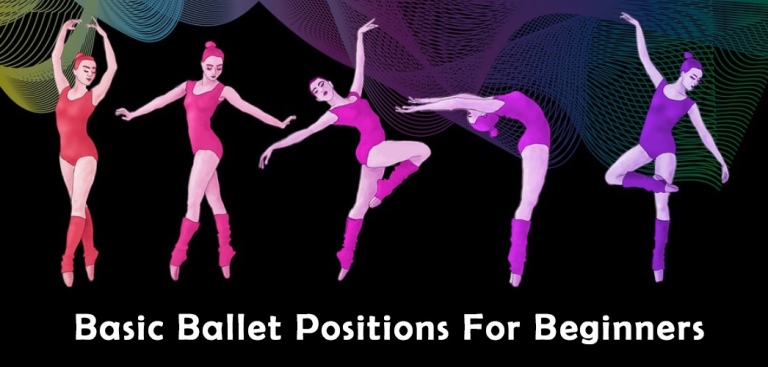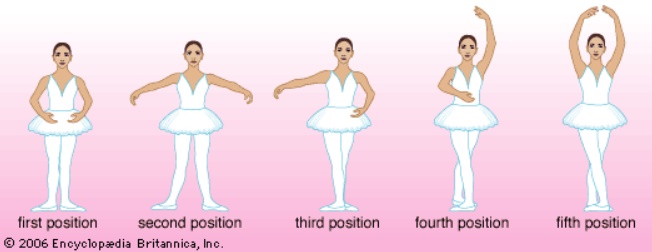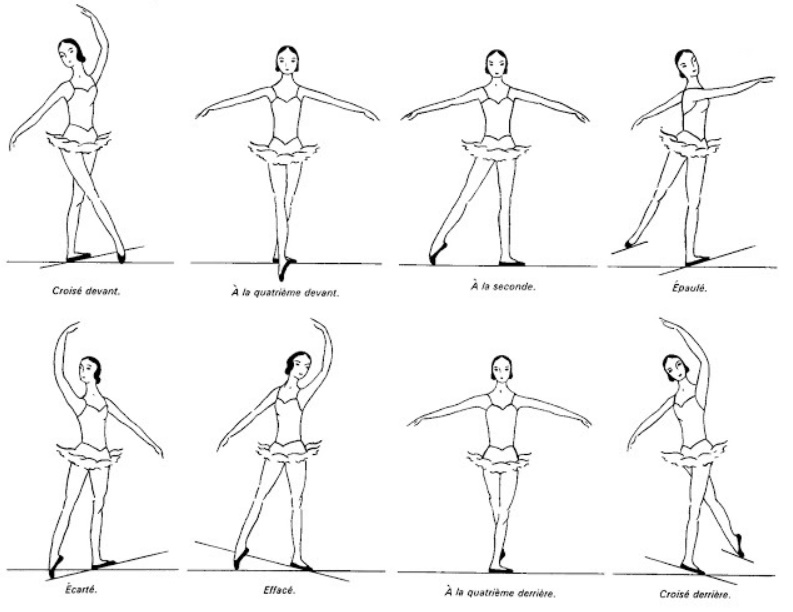Ballet seems to be an art with an unfathomable variety, but did you know all those beautiful movements come from basic ballet positions?
Every ballet teacher will make sure you do these positions right before anything else. And we have compiled them into an article that you can sneak a peek at whenever you want!
Table of Contents
Basic Ballet Feet Positions

There are five feet positions that an aspiring ballet dancer has to remember. All of them involve turnout, wherein their feet are seemingly turned outward from their ankles.
However, the turnout is a hip rotation instead of knee and ankle, hence your joints feel less pressure and are more versatile. You can practice new movements with both aesthetics and safety.
First Position Ballet
Being the first position, it’s undeniably the easiest out of the five. The dancer only needs to stand straight with their heels touched and their toes turned outward.
Advanced dancers can form a straight line using their feet, but beginners can stick to a V shape.
Focusing on keeping the heels in contact and maintaining the feet in a diagonal ankle is more important in the initial phase.
Second Position
The way you place your feet is the same as the first position, yet there must be a one-foot gap between your heels.
In relative precision, you can try to keep this gap in hip-distance or shoulder-distance. So, your heels are not too close or too far away from each other.
Third Position
Once again, you will start from the first position and put one foot in front of the other. The front foot should have its heel touching the middle of the behind foot.
You will hardly see this foot position in ballet exercises or choreographed pieces, though it still has a role in your ballet knowledge and skill.
Fourth Position
Here we are advancing to a higher level as the fourth position calls for more hip stretching.
We will start from the first position with our feet turned out equally and put one foot forward. Nonetheless, the placement of our feet will determine if it is ouverte (open) or croise (crossed).
With ouverte, the heels should be aligned. That’s why some people refer to it as ‘fourth opposite first’, for the foot is put forward in a straight line.
With croisé, the heel of the front foot is aligned with the joints of the toes behind. It’s also known as ‘fourth opposite fifth’. We will see what the fifth position has for us!
Fifth Position
The fifth position is the last and the most advanced ballet position for feet among the five.
It might take a dancer several years to reach completion with this position since it demands so much from their hips and feet.
From the crossed fourth position, pull your forward foot back. In a correct execution, your feet should form two parallel lines. The big toe of your back foot needs to touch the heel of your front foot.
Check more: How To Get Banana Feet Ballet?
Basic Ballet Arm Positions
You might be wondering how many positions for the arms you need to know and practice. Luckily enough, the number of positions remains the same.
All positions would start and end in a preparatory pose called bras bas, wherein you stand straight with your arms forming a slightly circular shape. Your elbows should have a nice curve without raising your hands too high.
First Position Ballet
From the bras bas, raise your hands until they are at the level of your waist without changing the distance between them.
Don’t forget to get the details right: your palms should face up against your torso, your elbows point to each side with nice support, and your shoulders remain relaxed.
Second Position
From the preparatory position, raise your arms and extend them to the corresponding sides.
For an accurate posture, don’t spread your arms into a horizontal line! They should have a natural and relaxed slope with elbows supported and palms turned forward.
Third Position
The third position is a combination of the mentioned poses, with one arm in the first position and one arm in the second position.
For better reference, you can draw an imaginary line as the vertical axis of your body. The arm in the first position shouldn’t cross this boundary.
Fourth Position
From the third position, raise your front arm over your head. Remember to maintain the natural arch of this arm and keep your extended arm relaxed.
Since the raise will put more tension on your arm, be sure to practice both arms equally so your body retains its balance.
Fifth Position
You will have a good start with the fifth position if you have nailed the first one. Now you only need to raise both your arms over your head while keeping the same distance.
Beginners usually don’t raise their hands too high because their core is not strong enough to hold the position. They will have to improve in this aspect and gradually move their arms backward.
However, the arms should never fall behind the axis of your body.
Body Ballet Positions
The essential body positions that every ballet dancer must know are Arabesque and Attitude.
Arabesque
A successful Arabesque is proof of your stable support and positioning. It is well-known for non-dancers as well due to how elegant it looks.
In Arabesque, we attempt to create a long line connecting our toes and our fingertips.
- All barre moves begin with the first position, wherein your toes are turned outward and your heels touch. Keep your arms on the front, relaxed and rounded, while your back remains straight.
- Slowly and steadily, lean your body weight onto your supporting leg (optional) and extend the active leg behind you. Put more strength in your core and keep your upper body upright.
- Reach one arm forth and let the other relax by your side before raising your active leg. Make sure the limb is straight and relaxed with pointed toes.
- Incline forward once your limbs are in the right position. The support for your upper body should come from your abdomen.
As you can see, Arabesque is quite open with no strict rules for the arms. And it spares room for four variations:
- First Arabesque: The arm on the same side as the active leg also extends backward in a diagonal line, while the other arm reaches straight and forward.
- Second Arabesque: The arm on the active side extends forth rises above the shoulders, and the other is lowered diagonally.
- Third Arabesque: Both arms are forward with a gap of twelve inches in between. The arm of the supporting leg will be slightly higher than the other, which is squared with the shoulders.
- Fourth Arabesque: Both arms are also forward, though the arm of the active leg will be the higher one instead.
Attitude
The Attitude posture is quite similar to Arabesque at first sight, though the bent knee makes the difference.
Even if you don’t take ballet lessons, you might still find this pose in many dance routines.
- Start from the first position. Put one foot forward about 30 centimeters without losing the alignment and the even distribution of your weight.
- Raise your arms to form a tender horizontal line and relax your fingers. The leg you put behind extends further backward with toes tucked.
- The dancer will bend their leg at a 90-degree angle and hold it in one of these three positions: Derrière – to the back, A la seconde – to the side, and Devant – to the front.
No matter what, they have to point their toes and maintain a slight bend in this leg while keeping their upper body prim and proper.
To perform this move correctly, make sure your raised knee turns more outwardly compared to your foot. The supporting leg can go pointe (difficult), demi-pointe (medium), or straight (easy).
Attitude is beneficial for people who want to stretch their legs and strengthen their glue. Beginners and pregnant women might also execute this position with the help of a barre.
Up next, we have the eight body positions – the core of all ballet moves. They are arranged in a certain order for better memorization.
Croise Devant
Crossed to the front is the literal meaning of croise devant. In this position, the dancer will face a corner. The leg closer to the audience is considered the working leg.
Hold your working leg in the fourth foot position and stretch it to the front (tendu). Your arms will also be in the fourth arm position, the lower arm is in accordance with the active leg.
It is often used as a start for pirouettes.
In ballet lessons, this posture is not usually done at the barre because most steps involving it are done in the center of the studio.
Check more: How To Do A Relevé In Ballet?
Quatrieme Devant
You will find some similarities between this position and croise devant because of the tendu. The differences are the dancer will face the audience instead and the arms will be in the second position.
It is included in many moves but is also a common pose to practice by the barre. You can get into a lot of positions such as degage, tendu, and many more.
Efface devant
Translated to shaded & to the front, the name indicated that the tendu is done with the leg away from the audience and your body also faces the corner.
Therefore, your body will shade the leg that is on the inside.
The arm closest to the audience will be in the third position, while the other holds a second-position pose. Your gaze will be under the raised arm and aim at the crowd.
You will see men doing this position more often since the space in front of them is left open. So female dancers can step in for pas de deux.
A la Seconde
Once again, you will face the crowd with one leg and both arms in the respective second position for each. (This pose of the upper body is en face, which you might be seeing so often!)
In various dance styles, they can turn a la seconde into a more jazzy pose with the leg raised in the second posture.
Croise Derriere
Croise derriere is pretty much the opposite of croise devant as your body turns to the corner and your head faces the audience. This is the ‘crossed’ in the name.
Subsequently, the tendu leg is behind the dancer and farther from the audience. The according arm is in the second and the other arm is in the third position. Hence, the dancer looks at the audience under their higher arm.
Ecarte
The sixth body position of ballet is another croise with two versions: devant and derriere.
In both versions, the dancer turns to the corner, one leg stretched to its side, the same arm in the third, and the opposite arm in the second position.
- Ecarte devant: the working leg in tendu is closer to the audience and the same arm rose in third. You will tilt your head up slightly towards this hand.
- Ecarte derriere: the working leg in tendu is farther from the audience and the same arm rose in third. You will tilt your head down slightly towards this hand.
When you are required to perform all eight positions in a sequence, ecarte devant is the one in use. But knowing both of them is still important in case you want to change things up a bit in your routine!
Epaule
You will face the corner for the seventh position, the working leg is closer to the viewers and extended in tendu arabesque. Its same arm reaches towards the corner and the other arm stays by your side naturally. Give your shoulders and head a slight incline.
Epaule is the root of Epaulement, a crucial concept in traditional ballet. It’s meant to get longer lines out of you with the mentioned incline. So your arabesque will be much more elegant and refined.
Quatrieme derriere
Eighth and last, quatrieme derriere is done with your eyes held straight ahead, arms spread delicately in second, and one leg stretched behind for a tendu.
The way you face your front makes this position ideal for barre exercises. It assists you to hone a perfect arabesque and practice keeping one of your legs extended behind.
Tips For Beginners
Everyone would agree that ballet is so much more than a dance style because it demands 100% of your effort and beyond.
Beginners will be facing a lot of challenges. These tips will help them maintain great conditions physically and mentally.
Preparation
The only thing you need to practice ballet is your body. Hence, you would want to be in your best shape before starting.
- Invest in footwear
Although ballet dancers typically have their signature outfits, anything neat and breathable would do the job. Meanwhile, you ought to be picky with your ballet shoes.
The perfect ballet footwear should cling to the balls of your feet and provide enough support, while bare feet and socks will never have the same effect.
- Stay hydrated
Ballet moves seem simple at first, though you still have to exert to get them right. Therefore, getting enough water and having a filled bottle with you is very necessary for a long session.
While You Practice
Besides the guide from your instructor, there are some notices you should keep in mind at all times so your body can reach its potential.
- Warm-up
Before you start, come to the barre and get some basic postures done (tendus or pliés) so your blood circulation has a good kick. This habit is beneficial when you learn more advanced moves as well.
- Mistakes are acceptable
Sometimes, new dancers think it is okay to skip a movement in their routines or not complete the posture at its extreme. This mindset will prevent them from improving.
With that being said, an instructor who can ease your anxiety is of great importance.
- Be aware of your posture
You will never be a trained ballerina with a slouching back because ballet is based on proper poses.
Thus, you should remind yourself time and time again to straighten your back. Eventually, it will become a good habit that you unknowingly keep up with.
- Improve flexibility
Ballet movements require a level of flexibility you can only achieve by constantly and regularly stretching your muscles.
Even when you are not doing ballet for a career, stretches are still helpful in assuring your safety and making your daily routines easier.
Outside of Class
If you want to be a skilled ballet dancer, only practicing in the studio wouldn’t suffice. Even after you get the positions right, it is still the surface of the iceberg.
For beautiful moves, you will need to combine those poses and incorporate your creative traits. Hence, spending some time every day to hone your skills is crucial.
Secondly, take good care of your body. After intense training sessions, it will need so much care and rest to avoid injuries. Ballet routines demand time and effort, you don’t have to push yourself beyond limits.
Don’t be shy to take videos of your dancing! You can have objective opinions on your improvement or send them to your teachers for feedback.
Trying to do better than yesterday also means you are challenging yourself, which is a very positive mindset!
Last but not least, listen to music as much as possible. Engross yourself with music so your sense of rhythm and melody could be enhanced immensely.
Final Words
Basic ballet dance positions are the essence, the spine of this art. It’s mandatory for new dancers to master these postures before learning different routines to perform.
We hope this compilation will help you memorize the steps much more quickly!


